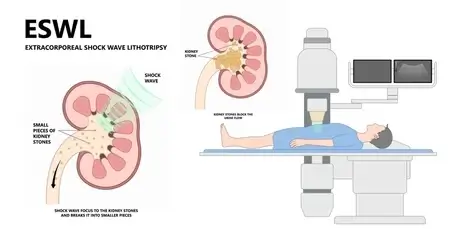Extracorporeal Shock Wave Lithotripsy (ESWL) is a non-invasive procedure used to treat kidney and ureteric stones. It involves using shock waves to break the stones into smaller fragments, which can then be naturally passed through urine.
ESWL is one of several treatment options available for kidney and ureteric stones. Other options include conservative treatment, percutaneous nephrolithotripsy, ureteroscopic lithotripsy, and open or laparoscopic surgery. In some cases, additional procedures may be necessary, such as inserting and removing a ureteric stent.
Table of Contents
The ESWL Procedure

During the ESWL procedure, the patient lies on a bed and a small shock wave generator is placed on their skin in the lumbar or abdominal region.
X-rays are used to locate the stones, and the patient may feel some discomfort during the procedure.
Pain relief medication can be given to alleviate any pain. The procedure typically takes about an hour.
Risk involved for ESWL procedure
Like any medical procedure, there are potential risks and complications associated with ESWL.
These can include common side effects like blood in the urine, painful urination, and kidney pain.
More serious complications, although rare, can include injuries to the urinary system, organ damage, infection, and loss of kidney function.
It’s important to note that this list is not exhaustive, and rare complications may occur.
How to prepare for a ESWL procedure
Before undergoing ESWL, patients will typically undergo a physical examination, blood tests, X-rays, and an electrocardiogram.
Certain medications, like aspirin or anticoagulants, may need to be stopped prior to the procedure.
Additionally, patients may need to follow specific dietary instructions and refrain from eating or drinking for a few hours before the procedure.
What happened after the ESWL procedure
After the procedure, patients may experience common side effects such as blood in the urine, painful urination, and kidney pain.
Bruising around the treatment site is also possible.
These symptoms usually subside within a week or two.
Patients are encouraged to drink plenty of water to help pass the stone fragments through the urinary tract.
After discharge
After being discharged, patients may experience frequent urination or slight blood in the urine.
They are allowed to resume normal activities like walking or climbing stairs, but should avoid straining or heavy lifting.
Follow-up appointments with a specialist are important to monitor the progress of stone clearance.
Disclaimer
It’s important to remember that this information is general and not exhaustive.
For more detailed information and specific guidance, it’s best to consult with a healthcare professional.
Please visit our Services Page to know more about our urological service and treatment.
